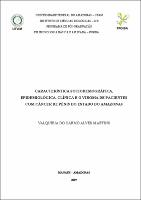| ???jsp.display-item.social.title??? |


|
Please use this identifier to cite or link to this item:
https://tede.ufam.edu.br/handle/tede/7989| ???metadata.dc.type???: | Tese |
| Title: | Característica sociodemográfica, epidemiológica, clínica e o viroma de pacientes com câncer de pênis do Estado do Amazonas |
| ???metadata.dc.creator???: | Martins, Valquíria do Carmo Alves  |
| ???metadata.dc.contributor.advisor1???: | Silva, Kátia Luz Torres |
| First advisor-co: | Levi, José Eduardo |
| ???metadata.dc.contributor.referee1???: | Naveca, Felipe Gomes |
| ???metadata.dc.contributor.referee2???: | Ramasawmy, Rajendranath |
| ???metadata.dc.contributor.referee3???: | Saito, Daniel |
| ???metadata.dc.contributor.referee4???: | Khayat, André Salim |
| ???metadata.dc.description.resumo???: | O Câncer de pênis apresenta alta incidência no Brasil, sobretudo nas regiões Norte e Nordeste. De etiologia heterogênea, pode estar relacionado à infecção pelo HPV ou por outros mecanismos moleculares. Neste estudo, A infecção pelo HPV foi observada em 45% dos casos. A infecção pelo EBV foi 30% e 25% apresentavam co-infecção com HPV. A análise de viroma de pacientes (HPV- e EBV-) não mostrou a presença de vírus com potencial oncogênico. Entretanto, foi observado que 99% de sequência mapearam com genoma humano, possibilitando a avaliação de múltiplas alterações genéticas. |
| Abstract: | Penile cancer is not an uncommon neoplasm in developing countries. Brazil appears among the countries with high incidence - particularly in the North and Northeast. The etiology of this neoplasm appears to be multifactorial; phimosis, retention of smegma, inflammatory processes, zoophilia, smoking, infection with oncogenic viruses such as Human papillomavirus (HPV) and Epstein-Barr virus (EBV) may be associated with the onset of cancer. The application of next generation sequencing (NGS) is a promising strategy in the discovery of potentially oncogenic virus in tumor tissue. Objectives: In order to understand the profile of penile cancer patients in the region, this study aimed to describe the sociodemographic, behavioral, clinical and viroma characteristics of penile cancer patients treated at a public oncology referral hospital in Manaus, Amazonas - Brazil. Methods: Forty-seven patients diagnosed with penile cancer from 2013 to 2018 were included in the study. Initially screening for oncogenic viruses (HPV and EBV) was performed by PCR. For the viral study by metagenomics we used the protocol NetoVIR - Novel enrichment technique of VIRomes. Results: The mean age of patients at the time of diagnosis was 57.4 years ±SD 17.8 ranging from 20 to 90 years old. Most patients had phimosis and come from the interior of the state of Amazonas or from other states (64% and 77%, respectively). HPV infection was observed in 45% (21/47) of cases. HPV16 was detected in 13 patients (61%). Other HPV types detected were HPV 6, 11, 42, 51, 53, 68 and 44/55. EBV infection was observed in 30% (14/47) of the patients with PC. The p16INK4a overexpression was observed exclusively in HPV 16 positive cases and four HPV negative cases. In the survival analysis, the follow-up time was 35.4 months/patient. The mortality rate during the follow up time was 38%. Thirteen patients with penile cancer non-HPV/EBV-associated were submitted viral metagenomic analysis. Bioinformatics analysis of high-throughput sequencing for virus detection combined two existing workflows which resulted in a range of 190-2,232 reads (< 0.1%) by Kraken and 458,189 – 1,277,735 reads (~6%) by Kaiju – RVDB. Interestingly, between 10-70% of the sequences remained unclassified, suggesting the potential of high throughput metagenomic sequencing studies, such as ours, to identify new microorganisms possibly related to cancer. Conclusions: Penile carcinogenesis has heterogeneous etiology and could be assigned HPV infection or molecular mechanisms independent of HPV. In this study, 27% (13/47) patients with penile cancer non-HPV/EBV-associated were analyses by NGS. Most of the DNA sequencing was found to represent unclassified sequences. As the bioinformatics analysis showed ~99% sequences to map against the human genome, it becomes possible to assess multiple genetic alterations and maybe to predict of outcome in penile cancer. |
| Keywords: | Epidemiologia - Pesquisa Neoplasia peniana Pesquisa sociodemográfica Papilomavírus Vírus Epstein-Barr |
| ???metadata.dc.subject.cnpq???: | CIÊNCIAS DA SAÚDE |
| ???metadata.dc.subject.user???: | Câncer de pênis Epidemiologia Viroma Metagenoma Amazonas |
| Language: | por |
| ???metadata.dc.publisher.country???: | Brasil |
| Publisher: | Universidade Federal do Amazonas |
| ???metadata.dc.publisher.initials???: | UFAM |
| ???metadata.dc.publisher.department???: | Instituto de Ciências Biológicas |
| ???metadata.dc.publisher.program???: | Programa de Pós-graduação em Imunologia Básica e Aplicada |
| Citation: | MARTINS, Valquíria do Carmo Alves. Característica sociodemográfica, epidemiológica, clínica e o viroma de pacientes com câncer de pênis do Estado do Amazonas. 2019. 121 f. Tese (Doutorado em Imunologia Básica e Aplicada) - Universidade Federal do Amazonas, Manaus, 2019. |
| ???metadata.dc.rights???: | Acesso Aberto |
| URI: | https://tede.ufam.edu.br/handle/tede/7989 |
| Issue Date: | 6-Dec-2019 |
| Appears in Collections: | Doutorado em Imunologia Básica e Aplicada |
Files in This Item:
| File | Description | Size | Format | |
|---|---|---|---|---|
| Tese_ValquíriaMartins_PPGIBA.pdf | Tese_ValquíriaMartins_PPGIBA | 9.77 MB | Adobe PDF |  Download/Open Preview |
Items in DSpace are protected by copyright, with all rights reserved, unless otherwise indicated.




